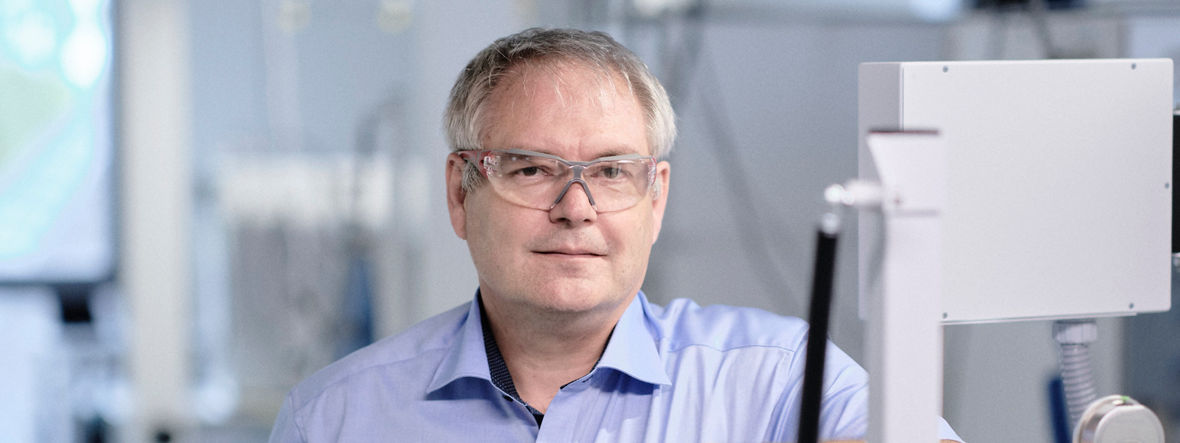Professor Waldvogel, the chemical industry in the European Union aims to achieve climate-neutral operation by 2050. What role is electrochemistry playing in this development?
Thanks to electrochemistry, we can use electricity as a primary energy source. This makes us less dependent on fossil sources of energy and reduces our carbon footprint. What’s more, we will need fewer raw materials for producing chemical substances, and less waste will be generated. And electrochemistry can help recycle substances more easily. In other words, it will become easier to enter the circular economy.

How soon can this transformation succeed?
It will take between 20 and 30 years for larger parts of the chemical industry to be electrified. But the process is making progress. In Germany especially, there’s a lot going on right now, for example within the future cluster “Electrification of Technical Organic Syntheses,” or ETOS for short. This project of the Federal Ministry of Education and Research has been running since April 2023—and many businesses are represented in it. The transformation will be a step-by-step process—not everything can start functioning immediately. However, there are already areas where we can demonstrate today that it works and that it pays off. As a result, people’s interest in this method is growing.
The relationships on which electrochemistry is based have been known for a long time. Why is this field experiencing a renaissance right now?
For one thing, people in the fields of business and science have realized that because of the climate crisis, something has to happen soon. For another, in recent decades there have been many innovations that make it easier to use electrochemical processes. For example, today some electrodes are being produced from sustainably manufactured carbon materials which replace expensive precious metals and poisonous mercury.
At the moment, the high cost of electricity in Germany is an obstacle to the rapid expansion of electrochemical processes. How can this technology become competitive?
It’s true that right now electricity in Europe costs five or six times as much as it does in the USA, but this situation is expected to change. Electricity will be our primary energy source in the future. Wind power and photovoltaics will make it more affordable—even though this will still take some time. Electrical storage systems will help to make electricity available in the future even during times like the periods of scarcity we have today. I believe that electrochemistry powered by renewable electricity is the only possibility of conducting chemical reactions in a genuinely sustainable way. That’s why it’s worthwhile to continue investing in electrochemistry, because it will give us an advantage over other regions.
ELEMENTS-Newsletter
Get exciting insights into Evonik's research and its social relevance – conveniently delivered to your inbox.
What fascinates you as a scientist about electrochemistry?
The diversity of the opportunities it offers. Especially for reactions that require a big input of energy, electrochemistry is often an elegant solution. Chemical bonds consist of electrons. If you add an electron or remove one, these bonds are activated. Until now, metals or other catalysts have often been used for this purpose. If an electric current is used, the removal or addition of electrons oxidizes or reduces materials much more strongly than the use of a chemical reagent. Reactions that we could not conduct previously suddenly become possible. The fascinating thing about electrochemistry is that it reduces the number of steps in a synthesis or requires fewer reagents. It also makes the processes more reliable.
How do you aim to promote electrochemistry at the Max Planck Institute for Chemical Energy Conversion?
Figuratively speaking, we are working on the white areas of this scientific map. Our incentive is our desire to be much better than traditional chemistry—by simplifying the synthesis or the processing of products. Of course we also want our developments to actually be used. So our ultimate goal is not just to develop an elegant process. We also need to have good arguments that persuade a management expert to implement it.
What kinds of projects are you working on right now?
In many cases we want to close material cycles so that we can continue using materials that were previously regarded as waste. For example, we are participating in two projects in Norway. The aim is to process lignosulfonates or kraft lignin—in other words, residual materials from wood processing—into valuable aromatic substances such as vanillin. The two processes are different, but both of them are now being tested for the first time on a pilot scale in an industrial environment. If these projects are successful, cellulose factories could be transformed into biorefineries.
Could processes like these also bring materials from contaminated sites back into the cycle?
Yes. One example is the insecticide lindane. It has been banned in the Federal Republic of Germany for many decades. However, many millions of tons of waste that were generated in its production process are still stored in landfills today in Germany, Romania, and Spain. Chlorine accounts for three quarters of the weight of this waste material. By splitting it off in an electrochemical process, we also obtain benzene or chlorinated products that are needed by industry. A further example involves combustion gases such as sulfur dioxide, which can be incorporated into organic substances by means of electrochemical processes. This yields sulfonamides, which are antibacterial active ingredients that can be used in human and veterinary medicine. Electrochemistry will even help to make the energy transition successful.

You’ll have to explain that a bit.
Let’s take chloralkali electrolysis as an example. This is the biggest electrochemical process we conduct in chemistry. To give you a sense of its importance, about 14 percent of the industrially used electricity in the federal state of North Rhine-Westphalia is used for this process. That corresponds to an output of several gigawatts. Now, if significantly more or less wind power is suddenly generated than was predicted, the industrial facilities can be operated with more or less power. This can help to stabilize the power networks.
Does this mean that electrochemistry can make production more flexible?
That is certainly an option. However, in order for that to happen the facilities would have to be constructed differently. In other words, production processes that have previously been operated at a constant level must be flexibly adapted to the available electricity supply. It should be possible for power consumers such as electric motors or electric heating systems to be flexibly switched on or off without greatly influencing the production process. This would be quite easy to do with electrolysis cells. Besides, some processes are so robust that they can double or triple their output without any problems. But it would be important to make the necessary peripherals big enough from the very start. You would have to integrate much bigger buffers than the ones that have been used so far.
Where do the limits of electrochemistry lie?
You always have to look at the individual case. For example, in principle we could produce ammonia using electrochemical processes. But there’s a catch to it: The process always generates a very dilute aqueous solution, but in most cases people want to have anhydrous ammonia for further processing. Today we already make anhydrous ammonia via the Haber-Bosch process—that is, through the synthesis of ammonia from atmospheric nitrogen. So in this case the traditional process has an advantage. However, producing the hydrogen required by the process accounts for most of the energy consumption—and hydrogen can be produced very well by means of water electrolysis. Another key factor is the purpose for which the ammonia is used.

Let’s say we use it for producing fertilizer…
In that case you’d be producing nitrates. There have been initial studies which show that the nitrogen can be directly oxidized to produce nitrate via electrochemical processes, thus skipping the interim step of ammonia production. This shows how important it is to think backwards from the final step of the process. The question is: Which product do you want to use, and what’s the best way to produce it in terms of the energy required?
Evonik is refining a specific variant of electrochemistry: electrodialysis. How exactly does it work?
The key elements of electrodialysis are the membranes. They are ion-selective—in other words, they allow either only negatively charged or only positively charged particles to pass through them. In this way they can separate substances. For example, they can separate out the acids or alkalis that are often generated as byproducts of chemical reactions. Basically, a system of this kind should run as long as possible without any manual intervention. However, the membranes have a limited service life. In the case of chloralkali electrolysis, they have to be replaced after about eight years. This is a complicated process that requires lots of manual work. Besides, this kind of membrane increases the system’s demand for energy; each individual membrane requires several hundred additional millivolts. As a rule, the most affordable process will ultimately prevail. Depending on the target molecule, this could be an electrochemical process such as electrodialysis or direct synthesis or sometimes a traditional process.
Is electrochemistry at all suitable for the production of basic chemicals?
In principle, yes. We’ve already talked about nitrates; however, the process for producing them is still in its infancy. We’re also still a long way from the commercial production of fuel. At the moment, electricity is still much too expensive for that. By contrast, the synthesis of organic compounds is in a different price segment. And a lot is already possible there, depending on the concrete product. In addition to the price, sometimes very different considerations also play a role. For example, today pharmaceutical companies use expensive and rare metals such as iridium and ruthenium as catalysts in some processes. Many of these metals are supplied by states that are not very reliable at the political level. That’s why it makes sense to consider alternatives.
Besides the economic and technical points, what is the greatest challenge facing the implementation of electrochemical processes?
We have to ensure that we have well-trained experts. Electrochemistry is more than doing battery research and learning about current-voltage curves. The manufacture and isolation of products is also important. In principle, this is preparative chemistry combined with electrochemistry. In other words, two disciplines come together here, and it would be a good thing if this was taught at multiple universities.




